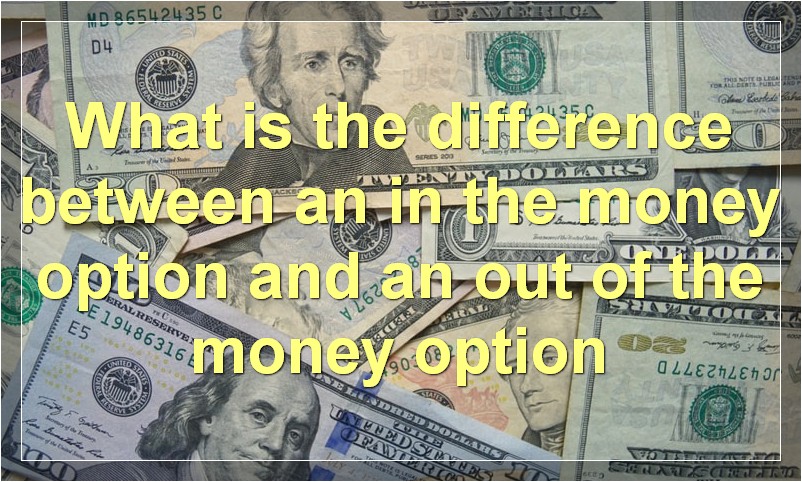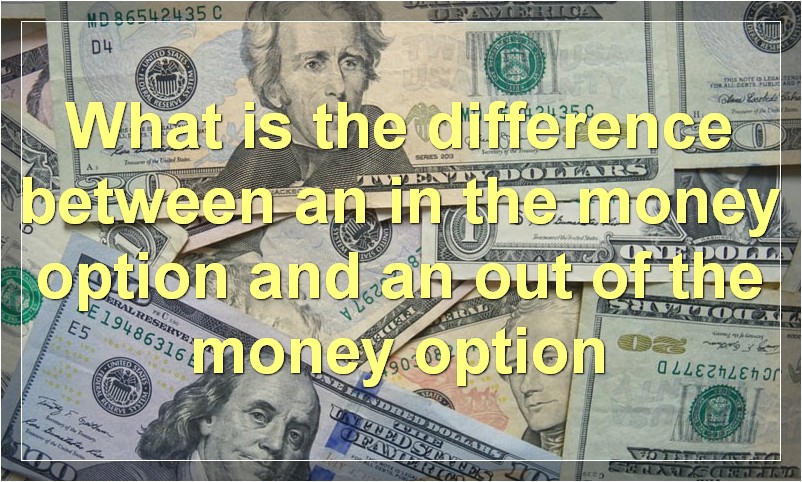If you’re considering buying an out of the money option, there are a few things you need to know. First, what is an out of the money option? Second, how do they work? And finally, what are the risks and rewards associated with them?
What is an out of the money option
An out of the money option is an option whose strike price is higher than the current market price of the underlying asset. For example, if you were to buy a call option on a stock that is currently trading at $50 per share, and the option has a strike price of $60, then the option is out of the money.
Out of the money options are cheaper than in the money options because there is less chance that they will expire in the money. However, this also means that they have less chance of making you a profit.
If you are thinking about buying an out of the money option, you should first consider whether you are willing to take on more risk in order to potentially make more money.
What is the difference between an in the money option and an out of the money option

An in the money option is an option that has intrinsic value. This means that the option is worth exercising because the underlying security is trading above the strike price for a call option, or below the strike price for a put option. An out of the money option is an option that does not have intrinsic value. This means that the option is not worth exercising because the underlying security is trading below the strike price for a call option, or above the strike price for a put option.
How does the strike price affect whether an option is considered in the money or out of the money
If an option has a strike price that is equal to or lower than the current price of the underlying asset, then it is considered to be in the money. If the strike price is higher than the current price of the underlying asset, then it is considered to be out of the money. The amount by which an option is in the money or out of the money is typically referred to as the intrinsic value.
Why would someone buy an out of the money option
When you buy an out-of-the-money (OTM) option, you are paying for the chance to make a profit if the underlying asset’s price moves enough in your favor. OTM options are cheaper than other options because they have a lower probability of finishing in the money.
Buying OTM options can be a good way to make profits if you are confident that the underlying asset’s price will move significantly in your favor, but it is important to remember that these options come with a greater risk of loss.
What is the downside to buying out of the money options
The downside to buying out of the money options is that they will typically have a lower chance of success than if you were to buy in the money options. This is because the underlying asset needs to move a greater distance in order for the option to become profitable. Therefore, you are generally taking on more risk when you buy out of the money options.
What happens to out of the money options when expiration approaches

When expiration approaches, out of the money options become increasingly less valuable. This is because the chances of the underlying asset price moving enough to make the option profitable diminish as expiration nears. Out of the money call options will typically expire worthless, while out of the money put options may still have some value if the underlying asset price is expected to decline significantly.
If an option is out of the money at expiration, what happens to the option holder
If an option is out of the money at expiration, the option holder will not receive any money from the underlying asset. However, the option holder may still be able to sell the option back to the market or another party before expiration.
Can out of the money options still be profitable
Yes, out of the money options can still be profitable. The key is to find the right strategy and manage your risk.
There are a few strategies that can be used to trade out of the money options:
1) The first is to simply buy out of the money options and hope that the price of the underlying asset moves in your favor. This is a relatively risky strategy as you are betting on the price movement of an asset.
2) Another strategy is to sell out of the money options. This is a more conservative approach as you are collecting premium from the option sale. If the price of the underlying asset does not move in your favor, you will still make a profit from the option sale.
3) A third strategy is to use out of the money options as part of a hedging strategy. This means that you would buy an out of the money option and simultaneously sell an in the money option. This way, if the price of the underlying asset moves against you, you will offset your losses with the profits from the in the money option.
No matter which strategy you use, it is important to manage your risk properly. Out of the money options are more risky than in the money options, so it is important to trade them carefully.
What factors should be considered when deciding whether to buy an in the money option or an out of the money option
When it comes to options, there are two main types: in the money (ITM) options and out of the money (OTM) options. ITM options have strike prices that are lower than the current stock price, while OTM options have strike prices that are higher than the current stock price. So, which type of option should you buy?
There are a few factors to consider when making this decision. First, what is your goal? If you’re looking to make a quick profit, then ITM options are usually the way to go since they typically have a higher delta (the amount by which the option price changes in relation to the underlying asset). However, if you’re looking to hedge your position or take a more long-term view, then OTM options may be a better choice.
Another factor to consider is time decay. All options lose value as they approach expiration, but ITM options lose value at a faster rate than OTM options. This is due to theta decay, which is the rate at which an option’s time value decreases. So, if you’re looking to hold an option for a longer period of time, OTM options may be a better choice.
Finally, you’ll need to consider your own risk tolerance. Buying ITM options is generally more risky than buying OTM options since there is less room for error. If the stock price doesn’t move in the direction you were expecting, you could end up losing all of your investment. On the other hand, OTM options offer more downside protection since the stock would need to move a greater distance in order for you to lose money.
Ultimately, the best type of option for you will depend on your individual goals and risk tolerance. Carefully consider all of these factors before making your decision.
Are there any strategies for trading out of the money options
There are a few strategies for trading out of the money options. One is to wait for the stock to move in your favor and then sell the option. Another is to sell the option when it is at or near its expiration date.

